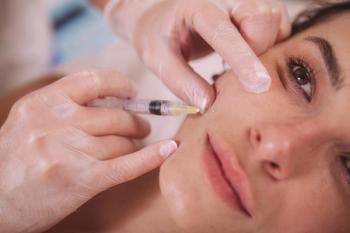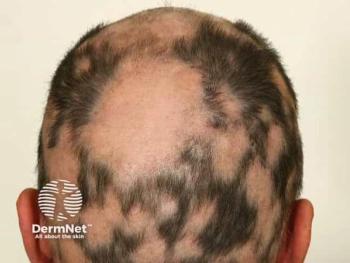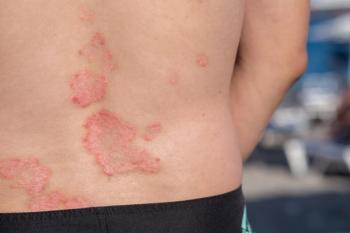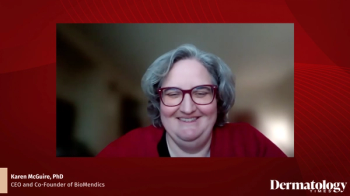
CG and Minoxidil Combination Therapy Shows Promise for AA
A recent review found glycyrrhizin improves minoxidil's efficacy in treating AA, showing reduced severity and improved hair density.
Although alopecia areata (AA) is often seen as a cosmetic issue, it can significantly impact a person's psychological well-being and self-esteem.1 Topical minoxidil, an FDA-approved treatment for androgenetic alopecia, is commonly used for AA, but its effectiveness alone is limited.2 Studies have reported that combination therapies have shown better results.3
With this in mind, a recent review focused on evaluating the efficacy and safety of combining topical minoxidil with compound glycyrrhizin (CG), which has anti-inflammatory and immunomodulatory properties. By analyzing relevant randomized controlled trials (RCTs), the study aims to assess this combination's potential as an optimized treatment for AA.4
Methods and Materials
The review involved searching 7 databases, including PubMed and EMBASE, using terms such as "alopecia areata," "glycyrrhizin," and "minoxidil." Inclusion criteria were RCTs reporting diagnostic criteria for AA, where the experimental group used CG combined with minoxidil, and the control group used minoxidil alone. Key outcomes included the Severity of Alopecia Tool (SALT) score and clinical efficacy, with secondary outcomes like serum levels of TNF-α and TGF-β1, and adverse events.Data were independently extracted by 2 researchers and verified, with disagreements resolved by a third researcher.
Results
The systematic review identified 196 studies across seven databases, with 101 duplicates removed. Of the remaining 95 studies, 67 were excluded after reviewing titles and abstracts, and 17 more were excluded after full-text review, leaving 11 studies for analysis. These 11 RCTs, conducted in China between 2009 and 2021, involved 1,189 participants and compared the efficacy of CG combined with topical minoxidil against minoxidil alone. The studies used CG at 50–75 mg applied 3 times daily and minoxidil at 2% or 5% concentrations for 2 to 3 months.
The meta-analysis found that combining CG with minoxidil significantly improved clinical efficacy compared to minoxidil alone (risk ratio (RR) = 1.36). Subgroup analysis showed researchers that this combination was effective for both 2-month (RR = 1.46) and 3-month (RR = 1.34) treatment durations. Researchers stated that CG combined with minoxidil also significantly reduced SALT scores (mean difference (MD) = −10.09), serum TNF-α levels (MD = −0.99), and serum IL-12levels (MD = −8.84), and increased serum TGF-β1 levels (MD = 2.40). The impact on serum IFN-γ levels was also found to be significant (MD = −7.44). Researchers reported no significant differences in the incidence of various adverse events between the 2 groups, and all adverse effects were mild and resolved quickly.
Discussion and Conclusion
CG inhibits Th1 cytokines and enhances Th2 cytokine IL-10, which helps regulate immune responses.5 Combined with topical minoxidil, which promotes hair follicle growth and improves microvascular circulation, CG potentially addresses both the immune and inflammatory aspects of AA.6
Previous trichoscopic evaluations revealed that CG and minoxidil treatment can reduce indicators of AA activity (e.g., black dots and broken hairs) and increases the number of short vellus hairs, suggesting improved hair density and reduced recurrence.5This analysis of 11 RCTs found that the combination of CG and minoxidil was more effective than minoxidil alone, reducing SALT scores and serum levels of TNF-α, IL-12, and IFN-γ, while increasing TGF-β1 levels. Researchers stated the safety profile was comparable to minoxidil alone, with no significant increase in adverse events.
However, they noted limitations include small sample sizes, regional biases (all studies were conducted in China), and moderate to low quality of evidence for some outcome indicators. Therefore, they suggested that more high-quality research is needed to validate the efficacy and safety of CG combined with topical minoxidil for treating AA.
References
- Ghalamkarpour F, Araghi F, Tabari M, et al. Comparing quality of life, anxiety, depression, sleep disturbance, and associated factors in vitiligo and alopecia areata patients. J Cosmet Dermatol. 2024;23(5):1808-1815. doi:10.1111/jocd.16158
- Gupta AK, Talukder M, Venkataraman M, et al. Minoxidil: a comprehensive review. J Dermatolog Treat. 2022;33(4):1896-1906. doi:10.1080/09546634.2021.1945527
- Nestor MS, Ablon G, Gade A, et al. Treatment options for androgenetic alopecia: Efficacy, side effects, compliance, financial considerations, and ethics. J Cosmet Dermatol. 2021;20(12):3759-3781. doi:10.1111/jocd.14537
- Guo C, Gu X, Li J, et al. Efficacy and safety of compound glycyrrhizin combined with topical minoxidil for alopecia areata: a systematic review and meta-analysis of randomized controlled trials. J Dermatolog Treat. 2024;35(1):2381766. doi:10.1080/09546634.2024.2381766
- Yang JY, Yang M, Chen ZH, et al. Effect of compound glycyrrhizin tablets combined with minoxidil tincture in the treatment of alopecia areata and the influence on serum levels of anti-TPOAb and Anti-TGAb. Chin J Aesth Med. 2021;30(12):93–97.
- Devjani S, Ezemma O, Kelley KJ, et al. Androgenetic alopecia: Therapy update. Drugs. 2023;83(8):701-715. doi:10.1007/s40265-023-01880-x
Newsletter
Like what you’re reading? Subscribe to Dermatology Times for weekly updates on therapies, innovations, and real-world practice tips.


















